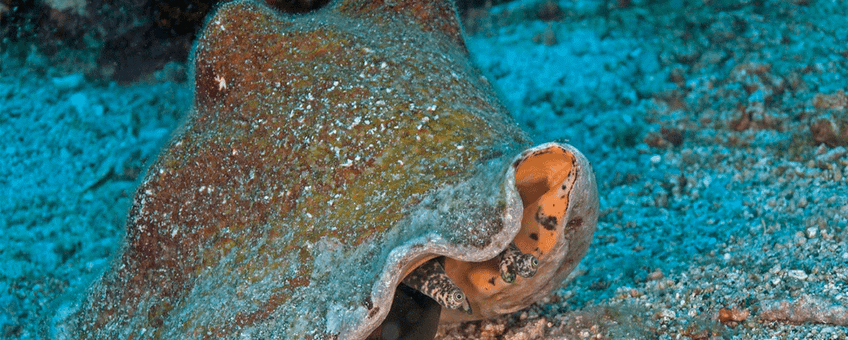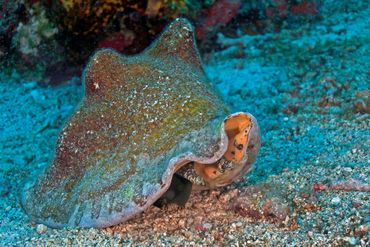
Shifting seagrass cues for queen conch
Caribbean Netherlands Science Institute, Dutch Caribbean Nature Alliance (DCNA), Florida Atlantic UniversityQueen conch is an iconic species for the Caribbean. In addition to their beautiful shell, queen conches are an important part of local cuisine. And they play a role in seagrass grazing, keeping algae growth under control. Queen conches are dependent on native seagrasses throughout their life cycle. In fact, conch start off as microscopic free-floating larvae, found throughout the water column. After about 21 days of swimming around, cues from their environment, namely native seagrass beds, tell them it’s time to settle and morph to a sand dwelling grazer.
The problem
 Unfortunately, native seagrass around St. Eustatius and other (Dutch) Caribbean islands are being threatened by an invasive species from the Red Sea: Halophila stipulacea. This new seagrass creates a completely different habitat, which affects how the ecosystem functions. This could lead to changes in the composition of populations and abundance of associated species, such as the queen conch. It is unclear if these invasive species offer the same cues to the conch larvae as their native counterparts. To better understand this, a new project is exploring these impacts. It is funded by World Wildlife Fund INNO-fonds and SPAW Regional Activity Center, led by the Caribbean Netherlands Science Institute partnering with Megan Davis from the Harbor Branch Oceanographic Institute at the Florida Atlantic University.
Unfortunately, native seagrass around St. Eustatius and other (Dutch) Caribbean islands are being threatened by an invasive species from the Red Sea: Halophila stipulacea. This new seagrass creates a completely different habitat, which affects how the ecosystem functions. This could lead to changes in the composition of populations and abundance of associated species, such as the queen conch. It is unclear if these invasive species offer the same cues to the conch larvae as their native counterparts. To better understand this, a new project is exploring these impacts. It is funded by World Wildlife Fund INNO-fonds and SPAW Regional Activity Center, led by the Caribbean Netherlands Science Institute partnering with Megan Davis from the Harbor Branch Oceanographic Institute at the Florida Atlantic University.
The project
The first step of the project is to collect eggs from wild queen conch. The female queen conch lays her eggs in a thin sticky thread-like casing. This thread bundles together into an egg mass, often covered in sand so it can be very difficult to find. Each thread contains millions of eggs, so only a small portion of this egg mass – about the size of a 25 cent coin – is needed for the experiment. Once collected the eggs are transported to a lab where they can be placed in a tank to be monitored daily. After four to five days the eggs will hatch, releasing many microscopic conch larvae into the tank.
Time to hatch
Once the eggs have hatched, the larvae are moved in small batches to individual beakers so they can be easily fed and monitored. Once they reach about one millimetre in length at about 21 days, they are almost ready for their metamorphosis. The final stage of the project is to introduce various cues to the larvae to see how they respond. In total four different cues will be used, in various combinations. These cues include two native seagrasses, the invasive seagrass and bare sand. After introduction, the conch larvae will be checked throughout the following week to see how they develop.
Want to know more about this project? Follow along with lead scientist, Dr. Kimani Kitson-Walters and check out the following vlog. Updates to this project will also be featured in future BioNews articles.
Take a look at the queen conch – under water and in the lab! (Source: Caribbean Netherlands Science Institute)
DCNA
The Dutch Caribbean Nature Alliance (DCNA) supports science communication and outreach in the Dutch Caribbean region by making nature related scientific information more widely available through amongst others the Dutch Caribbean Biodiversity Database, DCNA’s news platform BioNews and through the press. This article contains the results of one of those scientific studies but the study itself is not a DCNA study. No rights can be derived from the content. DCNA is not liable for the content and the in(direct) impacts resulting from publishing this article.
Text: DCNA
Photo: Marion Haarsma
Film: Caribbean Netherlands Science Institute
